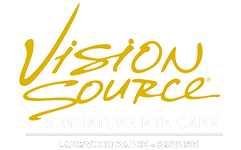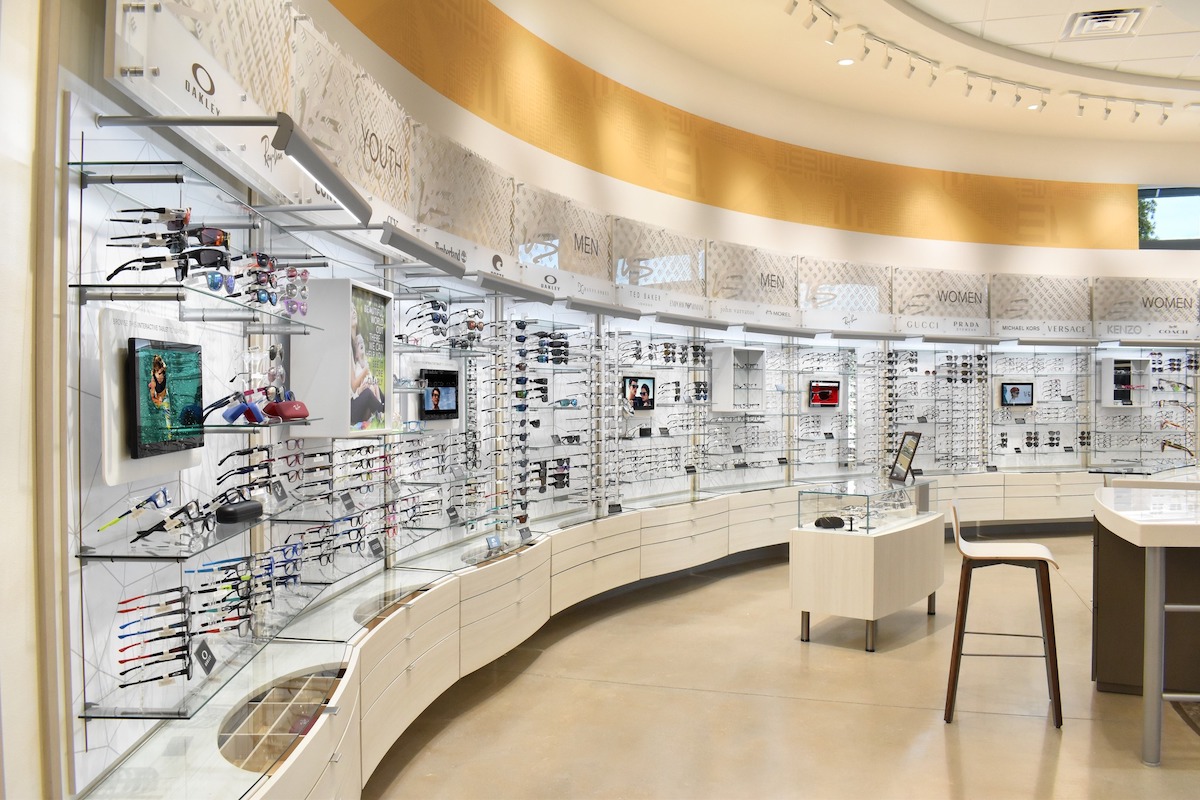Dry Eye Center of Excellence
We are the dry eye experts!
Are you suffering from dry eyes? Relief is right around the corner.
Some patients think that dry eye is a really simple problem, but it can actually be far more complex. The causes can be multifactorial. Due to the numerous causes for dry eye, a comprehensive evaluation is necessary to determine the source of the problem. Vision Source offers the latest advancements in diagnostic equipment so that we can properly establish an effective treatment protocol. Do you have dry eyes? People with dry eyes frequently experience burning and stinging of their eyes, their eyes often feel sticky, and their eyes are often red. For some people, the stinging, burning, redness and watering may seem like little more than a nuisance, but if left untreated, dry eye syndrome can lead to serious eye problems.
What are the symptoms of dry eyes?
- Stinging or burning eyes
- Grittiness or scratchiness
- Stringy mucus in or around the eyes
- Discomfort while wearing contact lenses
- Blurred or fluctuating vision
- Pain
- Light sensitivity
- A feeling of a foreign body or sand in the eye
- Excess tearing
- Redness of the eye
- Heavy eyelids
- Increased eye irritation from smoke or wind
- Decreased tolerance of reading, or working on the computer
How is dry eye diagnosed?
Patients who visit our Dry Eye Treatment Center receive a thorough medical evaluation that begins with a survey called a SPEED Questionnaire. The results from this questionnaire along with a medical examination helps our team facilitate disease detection and score the severity of the dry eye condition.
A state-of-the-art advanced diagnostic tool, called a Keratograph, is used for tear film analysis, oil gland imaging, and corneal contour evaluation. This analysis provides information on how fast tears evaporate, the oil layer thickness, and the water content of the tears. This information is critical to understanding the qualitative and quantitative aspects of the tear film while also providing measurements on which treatment effectiveness is monitored.
We have invested a significant amount of time and resources to acquire the most advanced equipment to diagnose and treat dry eye syndrome. In order to treat dry eye syndrome, you must diagnose it correctly. In our practice, we have the expertise and equipment necessary to accurate diagnose the condition and classify type of dry eye condition you have so that the treatment can be customized for you.
OCULUS Keratograph® 5M
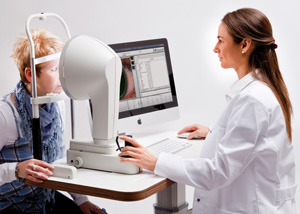 A New Way to Accurately Diagnose Dry Eye Disease
A New Way to Accurately Diagnose Dry Eye Disease
The OCULUS Keratograph® 5M integrates a high definition camera and corneal topographer into one seamless and state-of-the-art imaging machine. Ocular surface disease is match for this innovative tool, which integrates with computer technology to create detailed, full-color digital images of your eye. It is used to collect specific information including high resolution images and videos so that not only we can diagnose the cause of your dry eye, but also measure it in the future to see if we are making progress with your treatment. This device also allows us to capture special scans of the meibomian glands within the eye lid that are often the cause of dry eye syndrome. Furthermore, the actual tear volume can be measured. At the completion of all the individual tests, a report can be printed called the Crystal tear report that explains each test and how your results are scored.
The OCULUS Keratograph® 5 is a groundbreaking piece of imaging equipment that changes the way we diagnose and treat ocular surface eye diseases. This new machine is among the latest advances in optometry, it is especially useful for testing, diagnosing and treating dry eye disease.
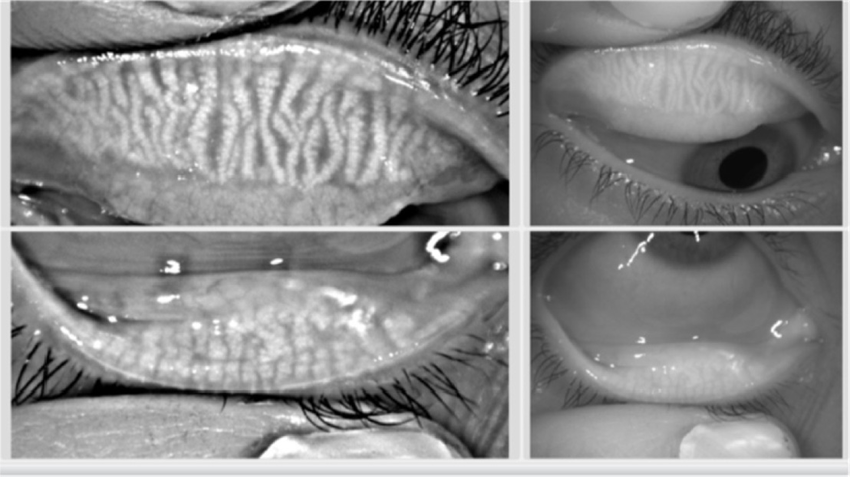
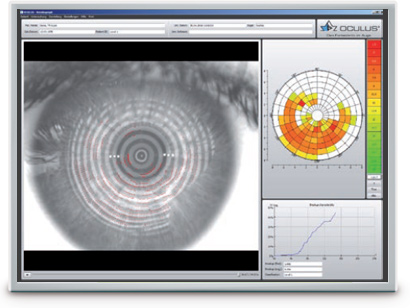
Dry eye testing may include the following:
- Patient history to determine dry eye symptoms
- Speed questionnaire to determine severity
- External examination of the eye, including lid structure and blink dynamics.
- Evaluation with the Oculus Keratograph 5M
- Imaging of oil glands, and corneal structural analysis.
- Measurement of the quantity and quality of tears for any abnormalities.
How is dry eye treated?
Dry Eye is a multifactorial disease and each patient’s condition is unique, therefore, several treatment options must be considered. Some dry eye treatments control symptoms while others aim to correct the underlying condition that is causing the dryness.
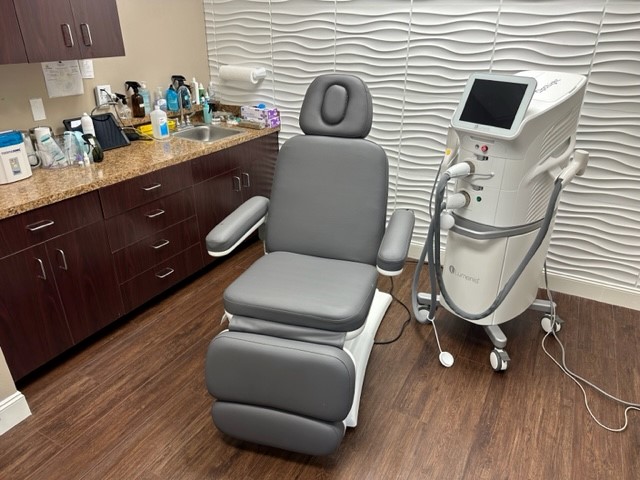
Optilight by Lumenis
Intense Pulse Light treatment (IPL)
OptiLight by Lumenis is a light-based, non-invasive treatment done in the area below the eyes to manage dry eye. It is the first and only IPL FDA-approved for dry eye management. The treatment is safe, gentle, and backed by more than 20 clinical studies. OptiLight uses precise pulses of light to reduce the inflammation that is typically associated with dry eye disease, improve tear break-up time, and increase meibomian gland functionality.
This application can significantly relieve dry eye indicators and has a multi-factorial effect including:
- Decreasing demodex and bacteria around the eyelids.
- Closing off blood vessels that release inflammation
- Inhibits the release of proinflammatory mediators
- Reinvigorates the meibomian glands and normalizes their secretions
- Allowing healthy oil production that protects your tears
It works to control the inflammatory process and to stop the vicious cycle of inflammation and to reduce the need for medications. IPL can can treat:
- Ocular rosacea
- Meibomian gland dysfunction
- Inflammatory dry eye
- Ocular surface disease
Treating your dry eye sometimes turns into treating yourself. IPL helps reverse the signs of aging by stimulating collagen production for younger-looking eyes. It has been used in dermatology for many years for skin rejuvenation. Often referred to as a “photofacial,” the treatment can be used to erase mild sun damage, age-spots, freckles or irregular pigmentation on the eyes, face and neck.
Optilight is performed in a series of 3-4 treatment sessions and sometimes used in combination with radio frequency as discussed below.
__________________________________________________________
FORMA
Radiofrequency Treatment (RF)
We also offer Forma Radiofrequency treatment for dry eye disease. Forma uses radiofrequency energy to generate heat which is applied to the skin around the eyes. This heat stimulates collagen formation, bringing white blood cells, and stem cells to the skin around your eyes while reducing inflammation. This treatment aids in opening up clogged meibomian glands, allowing for improved tear production and secretion. RF is usually followed by a Meibomian Gland expression. It also tightens the skin, minimizing the appearance of facial lines and wrinkles while improving skin tone.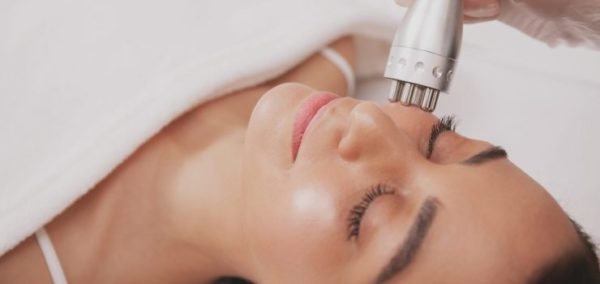
Forma Radiofrequency (RF) and Lumecca Intense Pulsed Light (IPL) treatments both work similarly and have a quick, same-day recovery, procedure time with immediate results, and reduction of fine lines and wrinkles. Our doctors prescribe one or the other and sometimes a combination of both therapies for your dry eye treatment. In addition, in some patients, our doctors will add another therapy as well, called Lipiflow, discussed below.
Bonus: Radiofrequency can help stimulate collagen and significantly tighten the skin to give you a more youthful appearance.
IPL and RF reverse the signs of aging by stimulating collagen production and work by smoothing wrinkles and eliminating dark spots for younger looking eyes. Forma is performed in a series of 5-6 treatment sessions and is sometimes combined with Lumecca intense pulsed light therapy.
_________________________________________________________
LIPIFLOW
Vector Thermal Pulsation Therapy (VTP)
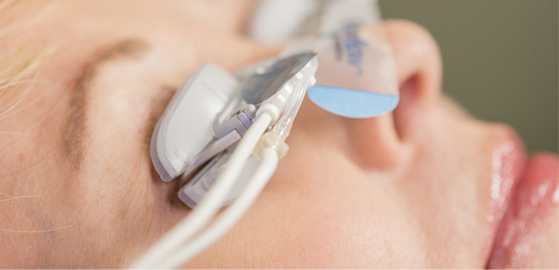 LipiFlow is an FDA-approved medical device for treating meibomian gland disease. It is a sophisticated technology based on the proven therapeutic use of heat and pulsation to relieve blockages. The procedure is quick and noninvasive. LipiFlow uses precisely controlled heat and massage to open blocked ducts and restore normal gland activity. Patented components called Activators deliver this treatment directly to the inner and outer lids while protecting delicate eye tissue. Sterile and single-use, the Activators are designed for patient safety and comfort. Each treatment takes approximately 12 minutes and it can be done right in our dry eye treatment room. Most patients experience improvement in symptoms in as little as two weeks. Lipiflow can be repeated in 9-12 months if necessary.
LipiFlow is an FDA-approved medical device for treating meibomian gland disease. It is a sophisticated technology based on the proven therapeutic use of heat and pulsation to relieve blockages. The procedure is quick and noninvasive. LipiFlow uses precisely controlled heat and massage to open blocked ducts and restore normal gland activity. Patented components called Activators deliver this treatment directly to the inner and outer lids while protecting delicate eye tissue. Sterile and single-use, the Activators are designed for patient safety and comfort. Each treatment takes approximately 12 minutes and it can be done right in our dry eye treatment room. Most patients experience improvement in symptoms in as little as two weeks. Lipiflow can be repeated in 9-12 months if necessary.
Important: The best dry eye treatment outcomes occur when Intense Pulse Light therapy or Radio Frequency is combined with Lipiflow.
__________________________________________________________
PUNCTAL OCCLUSION
Tear Preservation
If you visit your healthcare provider with complaints of dry eyes, you will likely be informed about “plugging your tear ducts,” or punctal occlusion. Punctal occlusion is a painless procedure in which the puncta (small openings in the corners of the eyes through which tears drain—the tear ducts) are blocked. Blocking the puncta increases the number of tears available to bathe the front part of the eye by decreasing the number of tears that drain away from the eye. Instead of plugging the gland that produces tears, punctal occlusion plugs the tear drainage pipe. (Think of plugging the drain in the kitchen sink—the faucet still runs.) A collagen or silicone plug is inserted into the puncta to decrease or slow tear drainage. The puncta is a small opening located on the nasal part of the inner eyelid. Two puncta are on each eye, one on the upper lid and one on the lower lid.
Important: Punctal occlusion is not for everyone. Punctal occulsion is a time-proven dry eye treatment. However, in some cases they can make problems worse. By keeping tears around, you may also keep inflammatory mediators and cells around increasing the amount of ocular inflammation. Our doctors will insert temporary plugs first as a trial to see how you do. If it works, you simply return for permanent punctal plugs. If it does not work, our doctors will switch to different treatment method.
__________________________________________________________
BIOLOGICS
RegenerEyes Lite and RegenerEyes Professional
Regener-Eyes® is a first in class, natural, biologic ophthalmic solution that is preservative free. Regener-Eyes® Ophthalmic Solution is available in a Professional Strength and LITE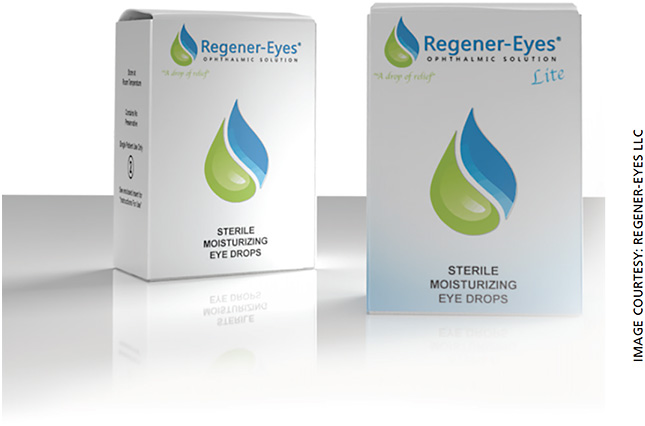 version. Most patients do well with Regenereyes LITE and more severe cases require the Professional Strength. Regenereyes contains:
version. Most patients do well with Regenereyes LITE and more severe cases require the Professional Strength. Regenereyes contains:
- Cytokines – anti-inflammatory – cytokines are a general term for all cell signaling protein molecules that function by attracting cells to inflammatory and/or infection sites
- Chemokines – signal the immune system for healing potential – chemokines are specific cytokines that function by attracting cells to inflammatory and/or infection sites.
- Growth Factors – may help trigger potential for cell regeneration – growth factors a subclass of cytokines that specifically stimulate the proliferation of cells, and hence, have the potential to improve wound healing through several mechanisms.
- Hyaluronic Acid – cushioning and moisturizing – HC-HA/PTX3 is a clear substance produced naturally by the body and is primarily found in skin, connective tissue and eyes. Its main function is to retain water and to keep tissues moisturized. It regulates several aspects of tissue repair including activation of inflammatory cells to enhance immune response.
These proteins and growth factors are natural, necessary for cell function, overall health of the eye, and homeostasis. This treatment has become one of our first line treatments for dry eye and ocular surface disease. Regenereyes is available for purchase in our office.
Amniotic Membrane Placement
PROKERA® biologic corneal bandage devices are used by eye doctors around the world to heal and treat ocular conditions such as keratitis, moderate to severe dry eye disease, recurrent corneal erosions, filamentary keratitis, persistent epithelial defects, neurotrophic corneas, herpetic ulcers, and many other ocular surface diseases such as chemical burns and Stevens-Johnson syndrome. Today’s patients are benefiting from research and an expanded set of tools for treating difficult conditions, and the use of amniotic membrane tissue is a good example of that. The innate healing properties of the tissue make it ideal for faster healing and tissue regeneration. It is especially helpful in the treatment of corneal diseases and degeneration. The amniotic membrane contains specialized proteins and growth factors that diminish inflammation, prevent drying, aid tear stability and accelerate healing.
__________________________________________________________________________________________________________________________
Scleral Contact Lenses
Large diameter rigid gas permeable lenses that rest on the sclera
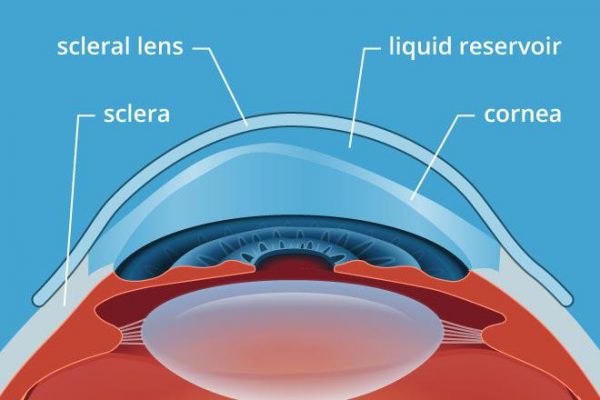 A scleral contact lens is a large rigid lens that rests on the scleral overlapping and vaulting the cornea, the part of the eye that keratoconus affects. Scleral lenses are unlike any other contact lens on the market. Because of their size (14mm to 24mm), they rest on the sclera. The sclera has considerably fewer nerve endings than the cornea. Fewer nerve endings means less sensitivity which ultimately means a very comfortable contact lens! In fact, most patients will report that scleral lenses are the most comfortable contact lens they have ever worn even when compared to soft contact lenses.
A scleral contact lens is a large rigid lens that rests on the scleral overlapping and vaulting the cornea, the part of the eye that keratoconus affects. Scleral lenses are unlike any other contact lens on the market. Because of their size (14mm to 24mm), they rest on the sclera. The sclera has considerably fewer nerve endings than the cornea. Fewer nerve endings means less sensitivity which ultimately means a very comfortable contact lens! In fact, most patients will report that scleral lenses are the most comfortable contact lens they have ever worn even when compared to soft contact lenses.
Between the scleral lens and the cornea, there is a fluid-filled reservoir. This reservoir fills in all the corneal irregularities and creates a perfectly rounded surface. Because they vault the cornea and provide a fluid-filled reservoir, scleral lenses are also a great treatment for severe dry eye disease and Sjorgren’s Syndrome. The dry corneal surface is constantly bathed in fluid so dry eye symptoms are quelled and the cornea has time to heal.
_____________________________________________________________________________________________________________________________
